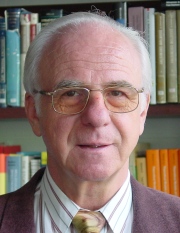

Werner Kutzelnigg

Born September 10, 1933 in Wien, Vienna.
Professor emeritus, Fakultät für Chemie, Ruhr-Universität Bochum, Germany.
Email:werner.kutzelnigg@rub.de
Web: external link
Carl-Duisberg-Gedächtnispreis der GDCh (German Chemical Society) 1971; Schrödinger Medal of WATOC 1995; Justus v. Liebig Denkmünze (GDCh) 1996; Dyonys-Ilkovich-Medal (Slovak Chemical Society) 1998.
Author of:
Einführung in die Theoretische Chemie (Wiley-VCh, Weinheim)
Bd. 1. Quantenmechanische Grundlagen 1975/1992
Bd. 2. Die Chemische Bindung 1978/1994
Bd. 1. Quantenmechanische Grundlagen 1975/1992
Bd. 2. Die Chemische Bindung 1978/1994
Important Contributions:
- Theory and implementation of new methods for the treatment of electron correlation, (a) invention of the IEPA-PNO-method (with R. Ahlrichs, V. Staemmler, M. Jungen), that has later (by W. Meyer) been extended to the CEPA-method, a precursor of the ab-initio implementation of coupled-cluster (CC) theory. (b) Use of explicitly correlated (r12-dependent) wave functions (with W. Klopper), without the need to evaluate complicated integrals (keyword R12-method). The R12-ansatz has been combined with Møller–Plesset perturbation theory (MP) and CC methods up to CCSDT1a (with J. Noga). (c) Formulation of the quantum mechanical many-body problem in terms of cumulants of the density matrices and their direct calculation (with D. Mukherjee).
- Magnetic properties of molecules, mainly NMR chemical shifts. The IGLO method (together with M. Schindler) was presented applied to various problems of organic and inorganic chemistry, e.g. structure elucidations (e.g. for carbonium ions) and assignment of tensor axes in solid-state NMR. Further development includes 'direct' IGLO (DIGLO, with U. Meyer) and multiconfiguration IGLO (MC-IGLO, with Ch. van Wüllen).
- Relativistic Quantum Chemistry. In this field fundamental problems were treated, like how to avoid the 'variational collapse', or the formulation of a 'direct perturbation theory' (DPT) of relativistic effects, which is not plagued by the spurious singularities of approaches based on the Foldy–Wouthuysen transformation.
- Contributions to a better understanding of the chemical bond, e.g. on the role of kinetic and potential energy, on the justification of simplified models, on the difference between first and higher row main group elements, on p-electron theory, on stereochemically active lone pairs etc.
- Mathematical studies of the rate of convergence of current expansion methods such as the 'partial wave expansion' (with J.D. Morgan) and the expansion in a Gaussian basis.
- Theory of intermolecular forces, mainly on properties of symmetry-adapted perturbation theory.
An obituary can be found here.